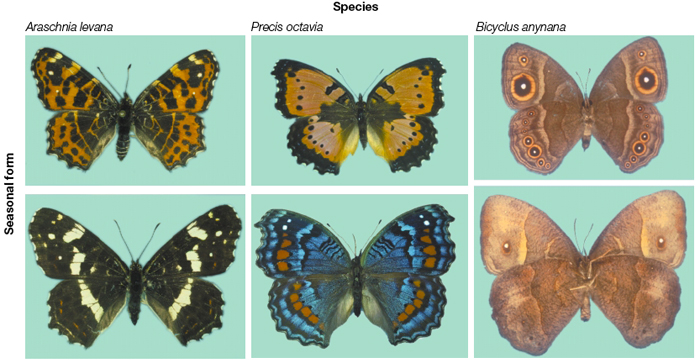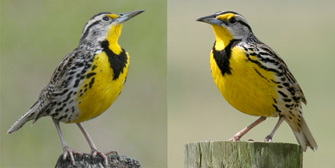« Prev Next »
Most people have a basic idea of what species are, even if they are not sure of the best way to define the word species. Quite simply, species are kinds, or types, of organisms. For example, humans all belong to one species (the scientific name of our species is Homo sapiens), and we differ from other species, such as gorillas or dogs or dandelions. But defining, identifying, and distinguishing between species really isn't that simple. In fact, it is often a complex and difficult process-especially in cases of new or previously unknown species. Biologists frequently disagree about species, and even argue over how best to define the word species. This disagreement is so well known, and so much discussed, that it is sometimes referred to by biologists as the "species problem" (Hey 2001).
This article explores the idea of species, including both the meaning of the word species, and how biologists think species can be identified in nature. It also examines why an understanding of species is important, both for the study of biology and for our society.
Why Are Species So Confusing?
To help understand the confusion and uncertainty over species, let's look at the most basic idea of Darwin's theory of evolution by natural selection. Darwin figured out a process by which species could change over time, and he believed that evolution was a slow and gradual process that played out over eons of time. So if species are changing slowly, and if new species are formed at the slow pace of evolution, then we absolutely expect there to be cases where we struggle to decide whether two kinds of organisms should be grouped as separate species or as a single species. In his book, On the Origin of Species, Darwin famously wrote, "I was much struck how entirely vague and arbitrary is the distinction between species and varieties." (Darwin 1859). In other words, Darwin did not believe that there was a definite point at which a species came into existence. Finally, because the large majority of species come into existence gradually, it is not surprising that we have difficulty deciding when to identify new species or what the best way to do so should be.
What Is a Species? How Do We Know a Species When We Find One?
Imagine you're a biologist on a research expedition to look for previously undiscovered kinds of butterflies. If you find some butterflies that seem different from those species that are already known (Figure 1), then you are faced with two questions. The first question is "what are species?", or to put it another way, "what makes a kind of butterfly an actual species of butterfly, rather than a sub-species or a genus?" The second question is "how should a species be detected?" The answer to this second question depends on the answer to the first question (i.e. "what are species?") but the two questions are not the same.

Two Classic Viewpoints on What Constitutes a Species
Ernst Mayr: Members of a Species Share Reproduction
In 1942 the famous biologist, Ernst Mayr claimed that what makes species different from sub-species and genera is that the organisms within a species can reproduce (i.e., produce fertile offspring) with one another, and that they cannot reproduce with organisms of other species (Mayr 1942). Mayr believed that individuals of the same species recognize each other as potential mates and are able to produce fertile offspring, but individuals of different species will either not attempt to reproduce with one another, or if they try they will not produce fertile offspring. The effect of this reproductive barrier is that different species do not exchange genes with each other and therefore evolve separately from each other. Mayr was not the first to state that this property of shared reproduction within species (and lack of reproduction between species) is what makes species different from genera and sub-species. But more than other biologists, Mayr emphasized using reproduction as the basis of species identification (see below); and more than most biologists before him, Mayr placed a strong emphasis on reproductive separation between species.
Did Mayr get it right? Is sexual reproduction the true essence of species? One significant problem with Mayr's idea is that some organisms, like bacteria and some eukaryotes, do not engage in sexual reproduction. For these organisms Mayr's ideas simply do not apply. But kinds of non-sexual organisms do exist, and biologists have divided them into a wide variety of different types or species, such as the thousands of species of bacteria that have been described. In these cases Mayr's idea that sexual reproduction defines species clearly is not appropriate. But for sexual organisms, such as most animals, plants, fungi and protists, Mayr's idea has been very useful.
George G. Simpson: Members of a Species Share an Evolutionary Process
Another idea was articulated by George G. Simpson. He said that something even more fundamental about species than Mayr's idea of shared reproduction is at work; that the members of a species have shared in an evolutionary process and an evolutionary history (Simpson 1951). Simpson's key idea is that a species is an evolutionary lineage that has evolved separately from other species. In other words, the organisms within a species all share in the processes of evolution. The processes of evolution, including genetic drift, migration and adaptation, cause there to be a thing, an entity made up of organisms evolving in concert and that collectively form a species (Templeton 1989).
Importantly, this property of evolving together does not apply to kinds of organisms above the species level. For example, birds are not evolving all together. There are many separate species of birds, each of which is on its own evolutionary path. The same goes for mammals and plants, and indeed for any inclusive kind of organism that includes multiple species. One nice point about the general idea of a species as an evolving unit is that it fits those organisms - such as many bacteria and some eukaryotes - that do not engage in sexual reproduction.
Mayr's and Simpson's Ideas Today
Identifying Species with the Biological Species Concept
For Ernst Mayr the answer to the question of how species are identified also boiled down to reproduction. In other words, Mayr was using the idea of reproductive separation of species to answer both the "what" and the "how" questions about identifying species (Mayr 1957). To Mayr, the key to identifying species is determining whether there is shared reproduction within a population of organisms and whether there are barriers to reproduction with other organism. Mayr called this idea of defining species on the basis of reproduction the Biological Species Concept, or BSC.

The Phylogenetic Species Concept Is an Alternate Approach
Using traits under the Phylogenetic Species Concept is a very different way of identifying species than using shared reproduction under the Biological Species Concept. But like the BSC, using the PSC accurately can still be challenging. Consider a group of organisms that all appear to be in the same population (e.g., maybe they are interbreeding with one another) and yet some individuals in that population are of a different color than the others. When we find different distinct organismal types within the same population, and those types are not uncommon, it is called a polymorphism. Yet under the PSC polymorphism might be interpreted as the presence of multiple species.
The Importance of Understanding Species
It is in the preservation of endangered species that many people are most likely to feel the impact of species questions. Many organisms of many kinds are affected by the societies and economies of human populations, often for the worse. For legal, ethical and economic reasons it is a big, and sometimes difficult, decision to conclude that a species is endangered. This is because in the United States, a species with endangered status receives protection that often affects the lives of the people in areas where protected species live.
Consider the case of the North Pacific Right Whale, which not very long ago was recognized as a distinct species based on genetic evidence and the Phylogenetic Species Concept (Rosenbaum et al., 2000). The genetic data--including mitochondrial DNA sequences--indicated that the North Pacific Right Whale has not been exchanging genes with other populations for a very long time. Because this whale population is so small, its new species status meant that the Endangered Species Act could be invoked. In 2008 the species was officially listed as endangered (Federal Register, 2008). However, there are thought to be only a few hundred of these whales still living and little has yet been done to protect their habitat. Habitat protection has wide-ranging governmental and political repercussions, including limits on shipping, fishing and oil-drilling activities in a part of the northern Pacific Ocean. In other words, it could be expensive to save the North Pacific Right Whale. Yet saving the Right Whale is important for ocean ecology, and thus for the thousands of other species that share the food web of the Pacific Ocean with the Right Whale. Saving the Right Whale is also important for strengthening peoples' connections to the beauty and wonder of the world's oceans and the life they contain.
Summary
References and Recommended Reading
Beldade, P. & Brakefield, P. The genetics and evo-devo of butterfly wing patterns. Nature Reviews Genetics 3, 446 (2002).
Cracraft, J. Species concepts and speciation analysis. Current Ornithology 1, 159-187 (1983).
Darwin, C. On the Origin of Species by Means of Natural Selection. Murray, London, 1859.
de Queiroz, K. Ernst Mayr and the modern concept
of species. PNAS 102 Suppl 1, 6600-6607 (2005).
Donoghue, M. J. A critique of the biological species concept and recommendations for a phylogenetic alternative. The Bryologist 88, 172-181 (1985).
Federal Register. Endangered Status for North Pacific and North Atlantic Right Whales. 73 FR 12024 (2008).
Hey, J. The mind of the species problem. Trends in Ecology and Evolution 16, 326-329 (2001).
Mayr, E. Systematics and the Origin of Species. Columbia University Press, New York, 1942.
Mayr, E. Species concepts and definitions. Pp.
1-22 in Mayr, E., ed. The Species
Prblem. AAAS, Washington, 1957.
Rosen, D. E. Fishes from the uplands and intermontane basins of Guatemala: revisionary studies and comparative biogeography. Bulletin of the American Museum of Natural History 162, 267-376 (1979).
Rosenbaum, H. C. et al. World-wide
genetic differentiation of Eubalaena:
questioning the number of right whale species. Molecular Ecology 9, 1793-1802 (2000).
Simpson, G. G. The Species Concept. Evolution
5, 285-298 (1951).
Templeton, A. R. The meaning of species and
speciation: a genetic perspective. Pp. 3-27 in
Otte, D. & Endler, J. A. eds. Speciation and its consequences. Sinauer
Associates, Sunderland, MA 1989.






























